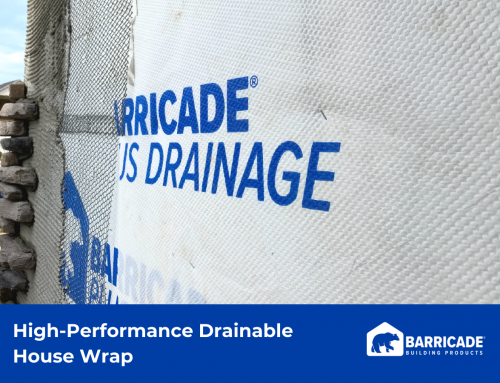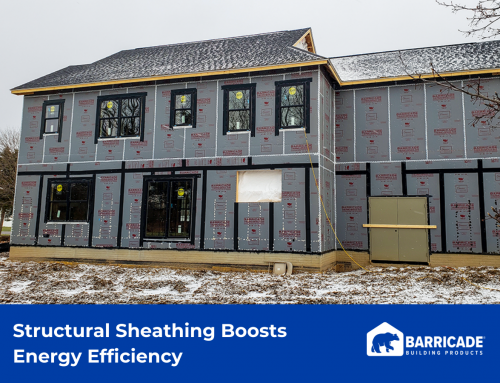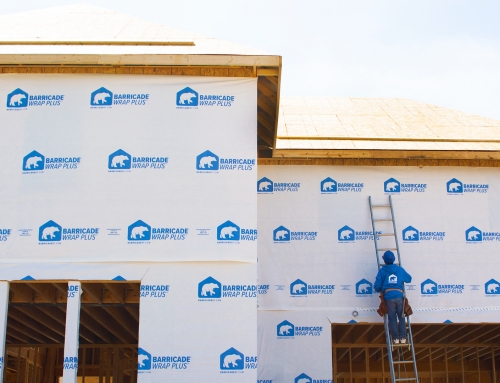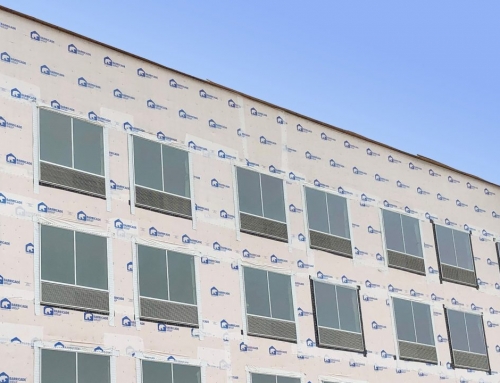The durability and strength of Barricade® Wrap Plus WRB can help protect a home against the heavy rains during a hurricane. Vapor permeability ensures that when moisture makes its way into the wall system it can evaporate, making it one of the most important features of the Barricade Wrap Plus.
During a hurricane season, homeowners in hurricane-prone regions brace themselves for the possibility of wind and water damage. Concernedly, an NOAA scientific review concluded that in the next century, greenhouse warming will cause more intense hurricanes with greater rainfall rates than present-day hurricanes. Families susceptible to hurricanes will need hurricane-resistant homes to protect them from the dangerous winds, rain, tornadoes, and flooding that can occur during a hurricane. However, for the safety of the home’s occupants during a hurricane, the Federal Emergency Management Association (FEMA) highly recommends a tornado safe room or shelter, built according to FEMA guidelines.
Moisture-resistance against wind-driven rains and surging water levels, wind-resistance with a continuous load path, and impact-resistant walls are essential features of a hurricane-resistant home.
1.Moisture-Resistant Design for a Hurricane-Proof Home
The design of a hurricane-resistant house must protect the home against moisture infiltration and accumulation from both heavy wind-driven rain and flooding.
Builders and architects of hurricane-resistant buildings should include four design features to combat moisture infiltration and accumulation during and after a hurricane event: deflection, drainage, drying, and durability.
Deflecting Rain from a Home During a Hurricane
Builders and architects can minimize a home’s exposure to rain during a hurricane by designing the house and its landscape to deflect the moisture.
- Plantings and landscaping around a house can reduce its exposure to wind-driven rain.
- Peaked roofs and overhangs can lessen rain deposition by about 50 percent.
- Surface features on the exterior of a house like trim, openings, and surface texture can deflect or disperse water that makes its way onto the exterior wall.
- Install eaves off the roofs so that they direct water several feet away from the face of the house.
- Recessed windows allow the exterior walls to deflect water away from the windows.
- Hurricane shutters can protect a home’s windows from the heavy rains of a hurricane.
Drainage Systems for a Hurricane-Resistant House
Even with deflective measures in place, some water will make its way onto a wall during a hurricane. Contractors should install effective drainage systems, like a footing drain and gutters with downspouts, to get the water off the house as soon as possible.
Hurricane-Resistant Design Includes Durable Products that Promote Quick Drying
During the intense winds and rain of a hurricane, water may make its way past the deflective and drainage measures and into the wall system. Therefore, contractors should use durable building products that won’t degrade when wet and can dry quickly, like a high-quality, vapor-permeable, weather-resistant barrier (WRB).
Vital elements of a high-quality WRB include durability, vapor-permeability, high tear strength, ultraviolet-resistance, and ease of installation. Most importantly, a WRB must comply with the 2018 International Building Codes (IBC 1402.2) requirements for water-resistance, and vapor permeability and the 2018 International Residential Code for water resistance (IRC R703.1.1).
Why Build a Hurricane-Resistant Home with Barricade® Wrap Plus?
Barricade Wrap Plus contains all the components of a high-quality WRB that can help contractors and architects build and design hurricane-resistant homes. Barricade Wrap Plus provides a continuous barrier over the entire building enclosure that resists water infiltration and accumulation during a hurricane. In addition, Barricade Wrap Plus provides durability over the expected lifetime of the home and has the strength and stiffness to resist damage during and after construction. See the benefits below:
- Resists water infiltration from rain and other sources during a hurricane event.
- Barricade Wrap Plus is durable. It has UV stability (nine months), with excellent tear-resistant strength, and cold- and surfactant-resistance.
- Barricade Wrap Plus has a vapor permeability of 16 US perms (much more than the mandated minimum for house wraps of five perms or higher), which allows moisture that infiltrates the wall system during a hurricane to evaporate.
- Ease of installation lessens potential damage due to errors during installation. Wrap Plus is also semi-transparent, which allows a view of the studs and sheathing, making it simpler to install than non-transparent building wraps.
- Meets and exceeds the air barrier specifications of the 2018 IECC 4.1 and C402.5.1.
2. A Continuous Load Path for a Hurricane-Proof House
When the severe winds of a hurricane attack a home, a continuous load path provides a strong defense towards keeping the house together. The continuous load path ensures that when a load, including lateral (horizontal) and uplift loads, attacks a house, the load moves from the roof, wall and other components toward the foundation and into the ground.
Hurricane-Resistant Roofs
House failures during hurricane events often start with damage to the roof. It only takes a Category 1 hurricane to damage the roof, shingles, and gutters of a wood-framed home. Overall, hip roofs have better wind resistance than gable roofs. It is important to know that the roof of a hurricane-resistant house must comply with Chapter 9 of the 2018 IRC, along with applicable local and state building codes.
Hurricane-Resistant Foundations
A hurricane-resistant foundation typically consists of floor joists spanning an open space. The floor joist size must resist loads to the entire floor along with vertical loads. The floor of a hurricane-resistant house ensures the loads meet their final destination – the ground. The foundation of a hurricane-resistant home must follow Chapter 4 of the 2018 IRC, along with applicable state and local codes.
Strong Hurricane-Resistant Wall Systems
The walls of a hurricane-resistant house must maintain their integrity during the high winds of a hurricane. Specifically, hurricane-resistant walls must have the structural capacity and stiffness to withstand the in-plane shear forces of hurricane winds in order to minimize the lateral twists that can damage the non-structural elements of a house such as the plumbing, mechanical, and electrical systems. Notably, the walls must comply with Chapter 6 of the 2018 IRC, along with applicable local and state building codes.
3. Impact Resistant Wall Systems
Flying debris during a hurricane can also damage the exterior of a home. Essential considerations for hurricane-resistant construction include exterior walls that stop the penetration of airborne hazards during a hurricane.
Today, more than ever, builders and architects recognize the importance of building and designing hurricane-resistant homes. Homeowners in hurricane-affected regions must not procrastinate and wait to comply with standards for hurricane-resistance. Contact Barricade® Building Products today for more information on building effective hurricane-resistant homes.







